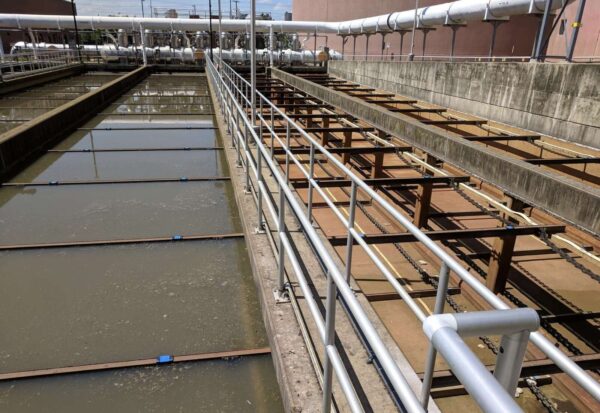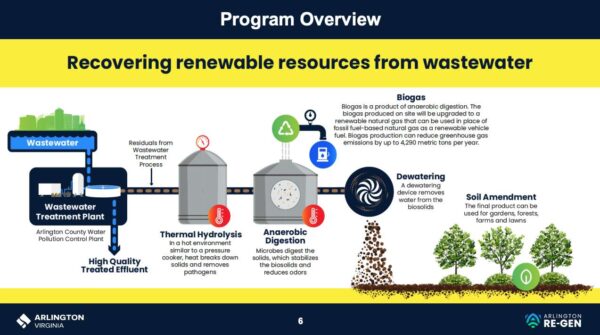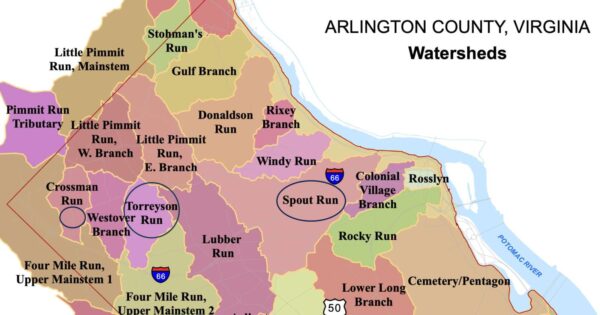
Your poop could give Arlington County natural gas to power buildings or buses.
The county is developing plans to upgrade its Water Pollution Control Plant, where local sewage goes. One change involves installing technology that can harness the methane emitted when human solid waste is processed, turning it into renewable natural gas, a process some municipalities have already implemented.
The energy could be used to power the wastewater plant, homes and commercial buildings or become an alternate fuel for ART buses. The “sludge” created through this process can also be used as a fertilizer for gardens, forests, farms and lawns. (If you’ve ever used Milorganite brand fertilizer, you’ve used dried sewage sludge from Milwaukee.)

Improvements to the wastewater treatment facility, to the tune of $156 million, are part of a $177 million bond request for utilities upgrades, which also includes improvements the regional Washington Aqueduct system ($15 million) and new gravity transmission mains ($3 million).
Funding for this work would come from a half-billion dollar bond referenda that voters will be considering on Election Day tomorrow (Tuesday). Over $510 million will go toward this work as well as a host of initiatives, upgrades and maintenance projects that Arlington County adopted as part of its 2023-32 Capital Improvement Plan.
Some big-ticket items have already grabbed headlines, like the $136 million requested to build a new Arlington Career Center campus and $2 million to design a proposed Arlington Boathouse on the Potomac River near Rosslyn. But there are dozens of other upgrades proposed for facilities that Arlingtonians of all ages use on a regular, and sometimes daily, basis.
Renovations to existing county buildings and the construction of new ones surpass $53 million.
Highlights include:
- $13.1 million for various renovations to Arlington’s police headquarters and, for the county’s courts building, technology upgrades, new finishes, a redesigned entrance and a relocated Juvenile and Domestic Relations Courts division.
- $12 million to fund the construction and renovation of some floors of 2020 14th Street N. to make room for ACFD Fire Marshal and Battalion Chiefs offices and other public safety staff and functions. It will also see the replacement of the building’s 60-year-old HVAC system.
- $7.5 million to acquire land next to the Serrano Apartments to build a fire station there and improve response times on the west end of Columbia Pike, given the pace of development along the Pike.
Overall, Arlington Public Schools is asking for $165 million. Of that, some $12.24 million would pay for safer school entrances, a measure many school systems nationwide are implementing in the wake of high-profile shootings, and new kitchens to allow more meals to be made in-house.
“Upgraded kitchens will allow students to eat high-quality meals that include more fresh fruits and vegetables that are prepared on-site,” according to APS. “The entrance and security vestibule updates will comply with current safety and security standards while ensuring all visitors check in at the main office.”

Another $16.8 million would pay for a new roof for Escuela Key, the Spanish-language immersion elementary school, HVAC replacement at Hoffman-Boston Elementary School and lighting upgrades across schools.
The Arlington Dept. of Parks and Recreation is asking for nearly $22.5 million for a dozen projects.
That includes some funding $1.5 million to replace and renovate some stretches of the county’s nearly 40 miles of off-street, multi-purpose trails, 56 pedestrian bridges and 11 low-water fords.
Preschool- and school-aged kids could have new playgrounds at Bailey’s Branch, Monroe and Woodmont parks sometime in 2024 ($2.8 million). Douglas Park will see $2 million in improvements, including a new picnic shelter, pedestrian bridge, stormwater management, invasive species removal and reforestation.
Athletes who play at Kenmore Middle School could have new turf fields ($300,000).
There’s $1.1 million in funding to design new facilities at Short Bridge Park, near the border of the City of Alexandria, as well as $1.8 million to redesign Gateway Park in Rosslyn, which the budget says is “difficult and dangerous to access due to the surrounding high-speed roadways” and is “under-utilized.”
People who live in the Ballston and Virginia Square areas would be able to get in on the ground floor of master planning processes ($1.5 million) next year to upgrade Maury, Herselle Milliken and Gum Ball parks starting as early as 2025.
The second, $4.4 million phase of work on Jennie Dean Park will move forward, including demolishing the existing WETA building, two parking lots and a portion of 27th Street S., installing a lighted basketball court and converting the existing court for tennis use.
The growing pickleball population, sometimes at odds with neighbors, and the dirt trail-less mountain bike enthusiasts could get new facilities through $2 million to convert tennis courts at Walter Reed Community Center for pickleball use, draw pickleball lines on some multi-use courts and fund “design improvements to natural surface trails and mountain biking improvements.”
Transportation comes to nearly $53 million.
Arlington’s contributions to Metro’s Capital Improvement Plan makes up the largest share of this, $42.6 million. Its six-year program focuses “safety, security, state of good repair and reliability” for rail and bus, as well as facilities, infrastructure and systems.
In Arlington, Metro plans to update fire alarms, security cameras, digital displays and signage at the Rosslyn and Courthouse stations, install a new canopy and new digital advertising displays and repair the deteriorating platform at the Arlington Cemetery station, and provide planning support for the planned east entrance to the Crystal City station.
Arlington estimates it will contribute $356 million to Metro over the next 10 years, through bond money, state grants, a regional gas tax and transportation capital funds.
The rest of the transportation bond money would be spent in smaller chunks:
- Annual repaving projects ($7.2 million)
- Annual bridge maintenance projects ($1.5 million)
- Improved street lighting ($1.1 million)
- Maintenance on the county’s closed circuit TV management system and related expenses ($200,000)
- New curbs and gutters along street sections where they are absent ($100,000)
Stormwater improvements total nearly $40 million. This includes upgrading pipes and installing water detention tanks to increase the capacity of certain watersheds to hold water during torrential downpours, like the storm in July 2019 that caused massive flooding and damage.
Arlington will target the Spout Run Watershed, which includes Clarendon and Courthouse ($13.3 million), the Torreyson Run Watershed, which overlaps with the Westover neighborhood ($6 million) and the culverts on Langston Boulevard and N. Sycamore Street, in East Falls Church ($6.75 million).

In addition to lessening runoff, stormwater improvements will go toward improving water quality. The county proposes to address erosion along the Gulf Branch stream ($2.75 million) and restore Sparrow Pond ($1.3 million).
The county has a triple-A bond rating, meaning that it has an excellent track record of paying back its debts as well as a strong ability to do so even in the face of adversity — for instance, the current rising interest rate environment and economic uncertainty.

